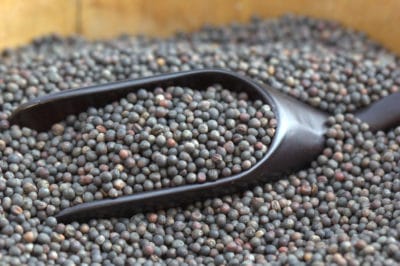Planting Kale Seeds to Transplant Outdoors
When you are planting kale seeds for seedlings that you intend to transplant outdoors, you will need to start them five to seven weeks before the last frost date for your area.
Use a potting soil mix that’s meant for vegetables or vegetables and herbs or mix your own. Kale prefers a sandy or loamy mix which you can create with the following blend:
- 40 percent sand
- 40 percent silt
- 20 percent clay
The soil pH balance should be between 5.5 and 6.8. Place the seeds 3 inches apart, and cover with 1/2 inch of the potting soil.
Allow the top layer to dry out between each watering, but keep the soil evenly moist at a depth of 1 inch. Be careful not to overwater your kale.
Planting Kale Seeds to Grow Kale in a Container
So long as it hasn’t been used to hold any hazardous or toxic substances, you can use almost any watertight container with adequate drainage holes to hold your kale.
Use the potting soil blends described above. No matter how large your container is, top soil is too heavy for container gardening.
If you will be growing your kale indoors, use a liquid organic fertilizer and keep it in a sunny space or use a grow light.
How you space your seeds depends on whether you are growing kale sprouts, baby kale or mature kale.
- If you are growing kale sprouts, you will want to pack the seeds tightly together in a shallow container.
- If you are growing your kale in individual containers, they should be at least 6 inches in diameter.
- If you are growing several kale plants together in a larger container, space the seeds 3 inches apart, and thin them after the first four true leaves appear so that each plant is at the center of an 8 inch to 12 inch space.
- If you are growing baby kale, you need less space between plants than if you are allowing your kale to reach maturity before harvesting it.
Planting Kale Seeds Outdoors
Wait until two to four weeks before the last frost date in your area before planting kale seeds outdoors. Choose a spot that will receive full to partial sun, and avoid muddy areas or areas where water tends to gather in puddles. As already mentioned, kale prefers well-drained, loamy soil.
Before planting, make sure that the pH of the soil is between 5.5 and 6.8. If you cover your chosen spot with compost that has already aged, work it into the soil, and you can plant the next day. If you need to apply a stronger organic fertilizer, wait two weeks before planting your kale.
Plant your seeds 3 inches apart in rows that are 18 inches to 24 inches apart, and cover them with 1/2 inch of soil.
The first two leaves that appear will be the cotyledon that nourish the plant until the true leaves appear. Wait until your kale is 4 inches to 5 inches tall and two to three sets of true leaves have developed to thin the plants.
If you are planning to harvest the leaves early as baby kale, you can allow the plants to be as close as 8 inches to 12 inches. If you plan to allow the plants to grow to maturity before harvesting, thin them to 18 inches to 24 inches apart.
